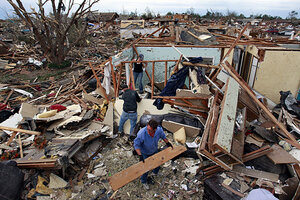Oklahoma tornado: Where the financial relief will come from
It will take more than $1 billion in insurance payouts and relief aid to help rebuild Moore, Okla., in the wake of Monday’s devastating tornado. Here’s where the money will come from, and where it is likely to go.

Jimmy Hodges helps Chad Heltcel and his wife, Cassidi, salvage belongings from the wreckage of the Heltcels' family home on Tuesday May 21, 2013, a day after a huge tornado moved through Moore, Okla.
Brennan Linsley/AP
Once the dust settles and the victims have been accounted for, Moore, Okla., will begin the gargantuan task of rebuilding itself, after an F-5, the highest possible in terms of wind speed and intensity, touched down there Monday, leveling everything in its path. It’s a task that, based on similar disasters, will take billions of dollars in federal and state aid, insurance claims, and charitable donations.
Moore has been through this before. In May 1999, a tornado, ripped through the Oklahoma City suburb, killing 36 and destroying 8,000 homes, costing $1.1 billion in damage. It was the costliest tornado disaster on record until 2011, when a tornado hit Joplin, Mo., and killed 161 people, costing about $2.8 billion in damage.
It’s early yet, but this week’s tornado likely won’t be quite that deadly or costly. But as Moore begins clearing away debris and rebuilding, here’s a breakdown of where the influx of relief money will come from, and what it will be used for.
Insurance
Tornadoes cost insurance companies a lot of money. The Joplin tornado marked the biggest insurance payout in the history of Missouri, with 61,000 claims generating $2.16 billion by May 2012, according to a data analysis from the Insurance Information Institute. Per the same study, the bulk of the payouts went not to private owners but commercial policyholders, who received about 64 percent of the money ($1.39 billion). Homeowners received approximately $675 million, or 31 percent of the total claims. A good chunk of that money likely went toward rebuilding – Joplin issued building permits for $310 million worth of construction in the year following the tornado.
Because of these massive payouts, insurers’ stock prices tend to take substantial hits in the wake of natural disasters. The latest tornado is no exception. Travelers, a property insurer, saw its share price fall 2.2 percent on Tuesday, while Allstate fell 1.5 percent.
“This mirrors Joplin, for sure,” State Farm spokesman Jim Camoriano told Bloomberg. “It is the same horrible caliber of disaster.”
Federal and state aid
Oklahoma governor Mary Fallin said in a Tuesday press conference that her state would dip into a “rainy day savings account” to match federal relief funds for Moore. Oklahoma received about $67 million in federal relief funds for the 1999 tornadoes; 12 years later, Joplin received about $350 million total (including a $131 million package in additional aid approved by Congress this past March). An estimated 20 percent of federal aid in Joplin was spent just on clearing away debris. The rest goes to temporary housing needs and ongoing infrastructure, like rebuilding schools.
Charitable donations
The American Red Cross, United Way, Salvation Army, and a slew of other charities are accepting donations for Moore. The funds those organizations receive will go largely to immediate needs, like food, water, temporary shelters, and medical care. According to the Joplin Globe, $32 million in relief money had been raised there by the end of May 2011, including $6 million from the Salvation Army and $5 million from the Red Cross (the total did not include donations made to the city's churches and church-affiliated charities).
The Moore disaster has already attracted a few huge private donors. NBA superstar Kevin Durant, who plays for the nearby Oklahoma City Thunder, donated $1 million to the Red Cross, and the Thunder organization matched his donation. Chesapeake Energy Corp. has said that it will donate $1 million to the Red Cross as well.

